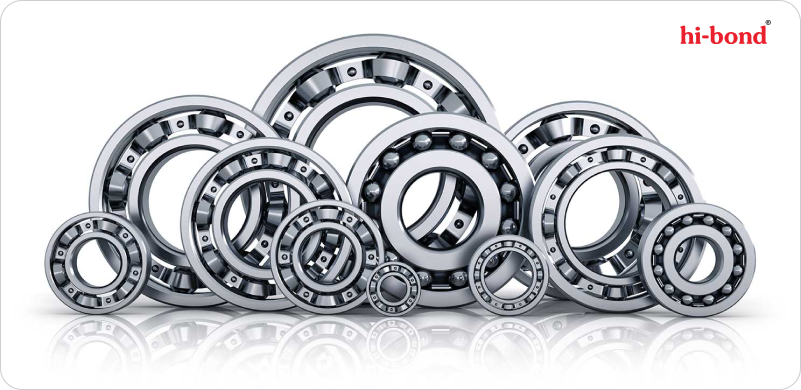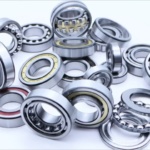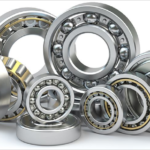Bearings are essential components in mechanical systems. Their primary function is to reduce friction and stabilize shafts, ensuring smooth operation. The installation of bearings provides excellent support for rotating machinery, resulting in better performance. Bearings are classified into two main types based on their friction properties: rolling bearings and sliding bearings. These broad categories contain multiple specific types. In this blog, Hi-bond, the expert bearing manufacturing company, will introduce you to the different types of bearings and their applications.
Each bearing type is designed for specific purposes and can carry radial loads, thrust loads, or a combination of both. Learn about different types of bearings and their applications in various industries.
1. Ball Bearings
Ball bearings are highly prevalent due to their fine ability to handle both radial and thrust loads, making them essential components in various industries. The classification of ball bearings includes
- Deep-Groove Ball Bearings: Widely recognized as the most commonly used roller bearing type, deep-groove ball bearings offer exceptional versatility and overall performance. Their distinguishing feature lies in the deep raceway grooves, where the inner and outer rings have slightly larger circular arcs than the balls. With non-separable rings, deep-groove ball bearings are suitable for applications requiring high-speed rotation, low noise, and low vibration.
- Angular Contact Ball Bearings: Engineered to withstand high radial-axial loads and achieve impressive speeds, angular contact ball bearings are designed with asymmetry for manufacturing purposes. They can only handle unidirectional axial loads and are often installed in groups of two or more opposed preloaded units, accompanied by rigid or elastic spacers. The contact angle between the cage ring and steel balls, typically 15°, 30°, or 40°, determines the bearing’s axial load capacity and rotational speed.
- Four-point Contact Ball Bearings: Can handle both radial and axial loads, four-point contact ball bearings offer a convenient alternative to the front or rear combination angular contact ball bearings. A single bearing can replace these combinations, simplifying installation and enhancing efficiency.
- Self-Aligning Ball Bearings: Featuring two raceways in the inner ring and the single spherical raceway in the outer ring, these bearings automatically correct misalignment caused by housing and shaft machining or installation errors. This unique design enables the inner ring, balls, and cage to deflect around the bearing center, accommodating shaft or housing deflection and misalignment. With their aligning capability, self-aligning ball bearings are ideal for applications requiring flexible adaptation to axis errors.
Applications of Ball Bearings
Ball bearings find widespread use in various domains, including:
- Household Items: Bicycles, skateboards, sewing machines, washing machines, tumble dryers, food processors, hair dryers, DVD players, fishing rods.
- Office Equipment: Photocopiers, fax machines, hard drives, fans, air conditioners.
- Industries: Elevators, assembly lines, escalators, medical and dental equipment, high-speed machine tooling equipment, paper-making machinery, chain saws, power tools, pumps/compressors, toy manufacturing, trains, and wind turbines.
- Automotive: Engines, steering systems, driveshafts and drivelines, electric motors, gearboxes, transmissions.
2. Tapered Roller Bearings
Tapered roller bearings efficiently handle radial and thrust loads, with the outer ring angle determining the bearing’s thrust load capacity. These components produced by a bearing manufacturer provide a true rolling motion by converging the raceways and tapered surfaces of the rollers at a common point on the axis of rotation.
Applications of Tapered Roller Bearings
They are used in various applications, such as agriculture, construction, mining equipment, sports robot combat, axle systems, gearboxes, engine motors and reducers, propeller shafts, railroad axle boxes, differentials, and wind turbines.
3. Spherical Roller Bearings
Spherical roller bearings allow low-friction rotation and angular misalignment support. Their spherical internal shape and rollers enable misalignment, while their profile resembles slightly over-inflated cylinders.
Applications of Spherical Roller Bearings
They are used in gearboxes, wind turbines, continuous casting machines, material handling, pumps, mechanical fans and blowers, mining and construction equipment, pulp and paper processing equipment, marine propulsion and offshore drilling, and off-road vehicles.
4. Cylindrical Roller Bearings
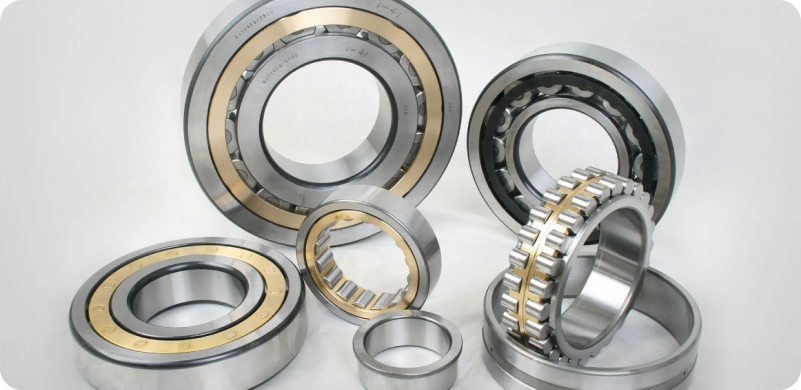
Cylindrical roller bearings are specifically designed to carry heavy radial loads, distributing the load over a larger area. They are not suited for thrust loads but can handle high-speed rotation. The bearings assembling needles are suitable for space-limited applications and work with smaller diameter cylinders.
Applications of Cylindrical Roller Bearings
Cylindrical roller bearings find applications in mining, petroleum production, power generation, cement processing, aggregate crushing, metal recycling, briquetting machines, rubber mixing equipment, rolling mills, pulp and paper machinery, construction equipment, crushers, electric motors, blowers and fans, gears and drives, plastics machinery, machine tools, traction motors, and pumps.
5. Needle Roller Bearings
Needle roller bearings use long, thin cylindrical rollers resembling needles. These bearings have the structure of inner ring bearings, but with needle rollers, they can be reduced in size while bearing large radial loads.
Applications of Needle Roller Bearings
Needle roller bearings are commonly used in automobile components like rocker arm pivots, pumps, gearboxes, and power transmission systems. They also find applications in two and four-stroke engines, planetary gear sets, air compressors, car engines, transmissions, pumps, excavator track wheels, hoists, bridge cranes, and compressors.
6. Slewing Bearings
Slewing bearings, also known as slewing rings, are rotational rolling-element bearings that support heavy, slow-turning, or slow-oscillating loads. They are commonly used in horizontal platforms such as cranes, swing yarders, and wind-facing platforms of windmills. Slewing bearings often blend gear teeth into the inner or outer race, allowing them to drive the platform relative to the base.
Applications of Selwing Bearings
These bearings find applications in various industries, including construction (cranes for bulk/scrap handling, container handling, concrete pumps, etc.), medical (radiotherapy applications, pharmaceutical production), water treatment, offshore mining, forest industries, radar military, and manlifts in fire trucks.
7. Thrust Ball Bearings
Thrust ball bearings are designed to support high axial loads, allowing rotation between parts. They consist of two washers (raceways) that may be grooved and rolling ball elements typically held in a cage. Thrust ball bearings can operate at higher speeds but lower loads than roller thrust bearings.
Applications of Thrust Ball Bearings
Thrust ball bearings are precisely used in various applications, including automotive, marine, aerospace, RC helicopters (main and tail rotor blade grips), car gearboxes, radio antenna masts, and clutch release bearings.
8. Plain Bearings
Plain bearings are the simplest bearing type, consisting of a bearing surface without rolling elements. They have a high load-carrying capacity and are generally less expensive than many other types of bearings. Depending on the materials used, these bearings can have much longer lifespans.
Applications of Plain Bearings
They find applications in turbomachines (power plant steam turbines, compressors), ship propeller shafts, and other critical pipeline applications. Plain bearings are known for their durability and ability to handle heavy loads efficiently.
9. Thrust Roller Bearings
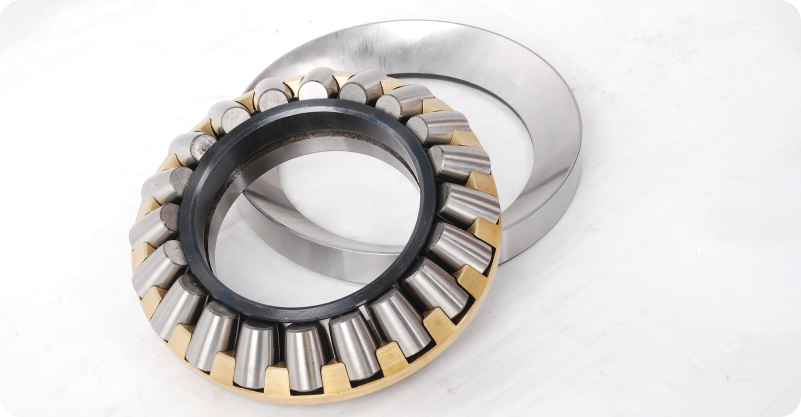
Thrust roller bearings are designed to withstand axial loads and are composed of a cage, bearing washer, and rollers. They are available with cylindrical, spherical, or tapered rollers and do not require lubrication.
- Cylindrical Roller Thrust Bearing: Cylindrical roller thrust bearings consist of washer-shaped raceway rings (shaft, seat washer), cylindrical rollers, and cage components. The cylindrical rollers are crowning processed to ensure even pressure distribution between the roller and the raceway surface. These bearings can bear single-direction axial loads with a large axial load capacity and exhibit strong axial rigidity.
- Needle Roller Thrust Bearing: Needle roller thrust bearings are a type of thrust bearing with needle-type rollers. Because they use needle rollers, they are commonly referred to as needle roller thrust bearings.
- Tapered Roller Thrust Bearing: Tapered roller thrust bearings are a type of thrust bearing where the rollers have a tapered shape. This design gives them the name tapered roller thrust bearings.
- Self-aligning Thrust Roller Bearing: Self-aligning thrust roller bearings have spherical rollers, which allow them to align themselves during operation.
Applications of Thrust Roller Bearings
- Cylindrical Roller Thrust Bearing: Oil rigs, iron steel, machinery manufacturing.
- Needle Roller Thrust Bearing: Transmission devices of cars, plowing machines, and machine tools.
- Tapered Roller Thrust Bearing: Unidirectional: Crane hooks, swivel oil rigs. Bidirectional: Roll neck of rolling mills.
- Self-aligning Thrust Roller Bearing: Hydroelectric power, vertical motors, marine propeller shafts, rolling mill rolling screws with a reducer, tower cranes, coal grinding machines, extruders, and molding machines.
10. Specialized Bearings
There are many other bearings that are designed for specific applications, offering unique features and advantages. Here are some common types of bearings and their specific applications:
Magnetic Bearings: These bearings support moving parts using magnetic levitation, allowing for low friction and no mechanical wear. They are used in various industrial applications such as electrical power generation, petroleum refinement, and machine tool operation.
Jewel Bearings: Jewel bearings are plain bearings where a metal spindle turns into a jewel-lined pivot hole.
Fluid Bearings: Fluid bearings support the load with a thin layer of swiftly moving pressurized liquid or gas. Compared to other types of bearings, they offer lower friction, wear, and vibration.
Flexure Bearings: Flexure bearings are compliant in one or more angular degrees of freedom and function similarly to conventional bearings or hinges. They require no lubrication and exhibit very low or no friction.
Applications of These Specialized Bearings
- Magnetic bearings are also used in uranium enrichment centrifuges and turbomolecular pumps.
- They are commonly used in precision instruments, particularly in mechanical watches, where low friction, long life, and dimensional accuracy are required.
- Fluid bearings find applications in heavy-duty rotating equipment, including hydroelectric plants and marine propeller shafts.
- Flexure bearings are used in various applications such as door hinges, lids for Pez dispensers, and flip-top covers.
Hi-bond: A Trusted Source for Different Types of Bearings and Their Applications to Suit Your Needs!
Now that you are familiar with the different types of bearings and their applications, it is important to choose a reliable bearing manufacturer and supplier for your bearing needs. Hi-bond Bearings Pvt. Ltd is a renowned manufacturer and supplier of high-quality bearings, including bronze casting and bronze bearings.
Our products are extensively used in various industries, such as automotive, agriculture, marine, and construction. You can also customize your options for nonstandard ball bearings to meet your specific requirements.
Contact Hi-bond Bearings Pvt. Ltd, the trusted bearings and bushes suppliers to get the perfect bearings for your applications.

